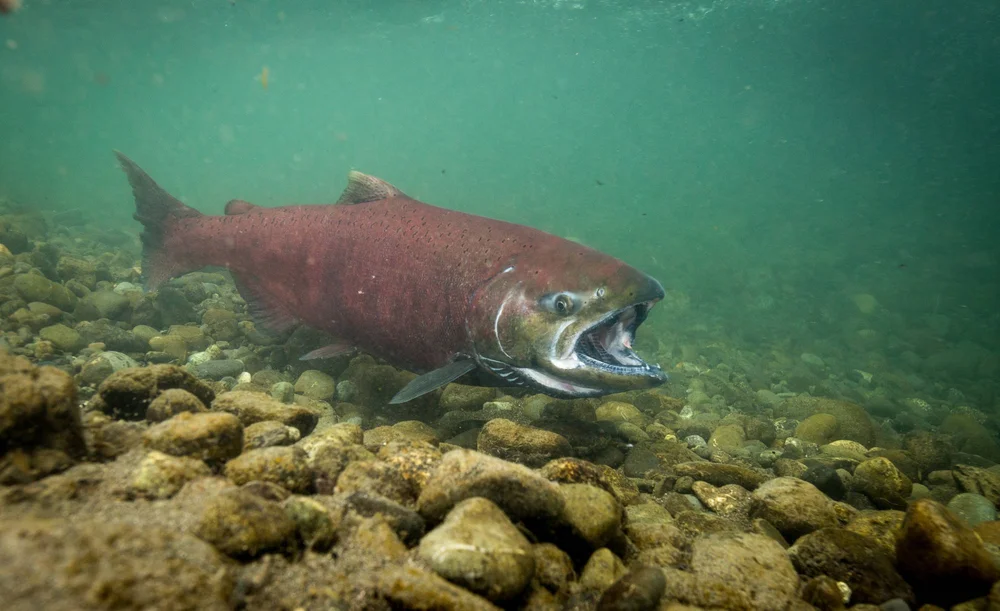Salmon campaign update, summer 2023

Where we are
As summer fades away, the wild spring and summer-run Chinook and sockeye that have returned to Snake River Basin headwaters are finding mates and digging redds in the gravels of their birth in order to spawn – while steelhead are settling into deep river pools to overwinter before spawning themselves. This vast, wild network of river habitat is too empty, with wild salmonids few and far between. Take an opportunity in the next few weeks to travel to a high tributary stream in central Idaho to witness the magic of returning salmon; use their scarcity to fuel your advocacy in the fight to remove the dams and recover our iconic wild fish to abundance.
Over the summer, the Biden Administration’s Council on Environmental Quality asked for feedback from the public on federal involvement with salmon recovery in the Columbia Basin and Lower Snake River Dams (LSRDs) removal and services replacement. IRU and our regional and national allies organized salmon advocates, and the response has been overwhelming – by the end of August when the comment period closed, the vast majority of the 60,000 people from across the country who commented had spoken up in favor of breaching the LSRDs and restoring the river in order to recover Snake River salmon.
A stay in the long-running salmon recovery litigation between the federal government and a coalition of fishing and conservation groups including IRU, as well as Oregon and the Nez Perce Tribe, was due to expire on August 31st after 22 months. U.S. government commitments to the region over this stay were outlined as:
“…supporting development of a durable long-term strategy to restore salmon and other native fish populations to healthy and abundant levels, honoring Federal commitments to Tribal Nations, delivering affordable and reliable clean power, and meeting the many resilience needs of stakeholders across the region.”
A brief two month litigation stay extension has been agreed to by the parties involved, with the understanding that the federal government will continue to move towards regional planning and implementation that fulfills the commitments outlined above. This agreement comes as the state of Washington moves forward on replacing the services of the LSRDs. Conservation partners and the Nez Perce Tribe secured three state budget provisions that dedicated millions of dollars of funding towards planning the energy transition, transportation options, and irrigation infrastructure associated with replacing the four dams.
Where we are headed
In late July, IRU, along with Columbia Riverkeeper, Northwest Sportfishing Industry Association, and Idaho Conservation League, provided 60 days notice of intent to sue the U.S. Army Corps over lethal hot water conditions for migrating sockeye salmon caused by the Lower Snake River dams.
The 60-day notice is not related to the stay in salmon recovery litigation, but seeks the necessary relief, up to and including dam removal, to endangered sockeye from prolonged summer hot water conditions in the Lower Snake River reservoirs. The late-migrating sockeye run bears the brunt of river conditions that are much warmer, for longer – caused by the four dams and exacerbated by climate change – as the fish return to the nursery lakes of the Stanley Basin in central Idaho.
The federal government can, and should, avoid this litigation by honoring its commitment to develop a credible plan to restore abundant Snake River salmon, including LSRD services replacement and dam removal. The 60-day notice serves as added layer pressure and accountability towards the Biden Administration’s commitments to the region.
In the fall, IRU will continue to engage in confidential mediation as part of the extended stay in the long-running salmon recovery litigation. In these forums as well as alongside our members and the public, we will continue to advocate for a comprehensive salmon recovery solution that addresses the historical inequities associated with dam construction and places our wild salmon and steelhead runs on a path towards “healthy and harvestable” abundance in the Snake River Basin.
This post originally appeared on News – Idaho Rivers United.


